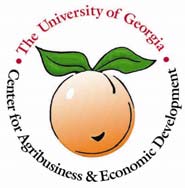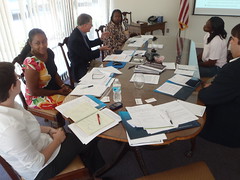On the right, Natasha Fast is explaining it to somebody.
First Friday, Valdosta, Lowndes County, Georgia, 3 September 2010, Pictures and videos by Gretchen Quarterman.
-jsq
On the right, Natasha Fast is explaining it to somebody.
First Friday, Valdosta, Lowndes County, Georgia, 3 September 2010, Pictures and videos by Gretchen Quarterman.
-jsq
The Valdosta Metropolitan Statistical Area (MSA) comes in the bottom 10 nationwide. That’s for overall average wages.
It doesn’t look quite as bad for specific classes of jobs (creative, service, and working class), but that’s mostly because there are almost no MSAs in the lowest pay tier. However, for service jobs, Valdosta is not as good as Tallahassee, and makes it into the bottom 10: Continue reading
 The UGA Center for Agribusiness and Economic Development has
quantified the economic effects of eating local food in Georgia,
in this report:
The Local Food Impact: What if Georgians Ate Georgia Produce?
Prepared by: Sharon P. Kane, Kent Wolfe, Marcia Jones, and John McKissick Center Report: CR-10-03 May 2010
The UGA Center for Agribusiness and Economic Development has
quantified the economic effects of eating local food in Georgia,
in this report:
The Local Food Impact: What if Georgians Ate Georgia Produce?
Prepared by: Sharon P. Kane, Kent Wolfe, Marcia Jones, and John McKissick Center Report: CR-10-03 May 2010
If Georgians produced all of the fruits and vegetables that they consumed, it could provide a way to close this utilization gap (the difference between state-wide production and consumption) of over $780 million per year. Even if this level can’t be achieved, simply closing the gap in one commoditylettuce, for examplecould mean an additional $83.6 million of direct revenue to local producers.
What is the lettuce gap? The Cordele Dispatch explains it: Continue reading
 This is part 2 about the July 8th
town Hall meeting about the biomass plant proposed for Valdosta.
This is part 2 about the July 8th
town Hall meeting about the biomass plant proposed for Valdosta.
First let’s hear George Rhynes explain that it’s never too late to reregulate our minds:
Here I’ve selected videos of local County Commission candidates: Continue reading
 Juarez, Mexico, is farther down the road of emphasizing law and order
over education and jobs, as Melissa del Bosque reports in the Texas Observer abo
ut
Mexico’s Lost Generations:
Juarez, Mexico, is farther down the road of emphasizing law and order
over education and jobs, as Melissa del Bosque reports in the Texas Observer abo
ut
Mexico’s Lost Generations:
When Juarez’s (soon to be outgoing) Mayor Jose Reyes-Ferriz visited Austin last April something he said stuck with me.Mexican president Calderon, previously consumed by the drug war, finally noticed and did something:He told the audience that a failure to invest in schools and other public infrastructure had led to the lawlessness in his city. Instead of schools and daycare centers, city leadership only invested in maquila parks and roads. Children were left on the streets to fend for themselves as their parents worked in the maquila factories for meager wages.
“More than 5,000 residents have received job-training grants or temporary work sprucing up parks and sidewalks and planting trees. Officials added thousands of families to a government insurance program and handed out 6,000 scholarships in a city where few students were receiving such help.”Todos somos Juarez (We Are All Juarez).“It’s not enough to analyze it only in terms of public safety. You have serious gaps in the social and economic [areas] that have to be closed,” said Antonio Vivanco, a Calderon advisor overseeing the development effort.
-jsq
 In the VLCIA meeting with concerned citizens of 10 June 2010, one of the action items taken by the VLCIA was:
In the VLCIA meeting with concerned citizens of 10 June 2010, one of the action items taken by the VLCIA was:
Obtain, if available, an analysis of the property value trends of residential/ commercial property adjacent to the Cadillac Michigan biomass electric generating plant.Col. Ricketts has reported back on that action item.
My transcription of what he said is rather long, so please follow the link.
Allan Ricketts’ summary: nobody could find a systematic analysis of property value trends. He did get various personal analyses (as above).
I agreed he’s made a good effort to find what he could find.
And that we would continue looking in other sources.
-jsq
 Jade Bulecza reports for WALB that
Teachers take outdoor learning to the classroomTeachers take outdoor learning to the classroom:
Jade Bulecza reports for WALB that
Teachers take outdoor learning to the classroomTeachers take outdoor learning to the classroom:
About 25 teachers from Lowndes County schools were out at the Pine Grove Farm in Thursday identifying trees and looking at leaves.Maybe later they could even take the students out to the trees!It’s part of project learning tree, an environmental education program.
Renee Galloway says students don’t really get out of the classroom in language arts and reading, so she’s glad she’ll have new lessons to bring to her class.
“Hopefully, our teachers can take back the importance of the timber industry to Georgia’s economy to their classrooms,” said Joy Cowart, a Project Learning Tree facilitator.That’s one good lesson. Others might be the diversity of native forests and the economic and natural benefits of reforestation.
 Carrie Teegardin and Bill Rankin
write in the AJC about
A billion-dollar burden or justice?
AJC investigation: Georgia leads nation in criminal punishment:
Carrie Teegardin and Bill Rankin
write in the AJC about
A billion-dollar burden or justice?
AJC investigation: Georgia leads nation in criminal punishment:
Georgia taxpayers spend $1 billion a year locking up so many criminal offenders that the state has the fourth-highest incarceration rate in the nation. When it comes to overall criminal punishment, no state outdoes Georgia.They note that scare tactics made that happen.
But today, many public figures with strong anti-crime credentials are asking if that expenditure is smart, or even if it’s making Georgians safer. The debate about crime and punishment, once clearly divided along party lines, is now a debate in which conservatives often lead the charge for change.Continue reading
Principal Mrs. Mickie Fisher MCs a picnic on the grounds of Pine Grove Elementary (PGE) to celebrate its 140 years of operation before it moves to its new location. The last day of classes is Wednesday. First, hear former prinicpal Reuben Jenkins, Clerk or Courts Sara Crow, and especially the PGE Chorus: Continue reading
On April 28 Deneige Broom wrote, Proposed Plant Raises Air Quality Questions:
A Biomass plant could bring business and money to the area. But some want to be assured their health won’t suffer in the name of progress.Some good quotes in there:
Dr. Brad Bergstrom attended the hearing wants concrete answers.Continue reading“There’s not going to be anything in the permit that will say, you can only burn this much sewage sludge,” said Bergstrom. “The company plans to only burn a small percentage but once they get their permit, that could change.”